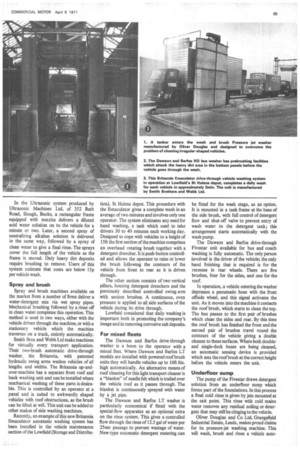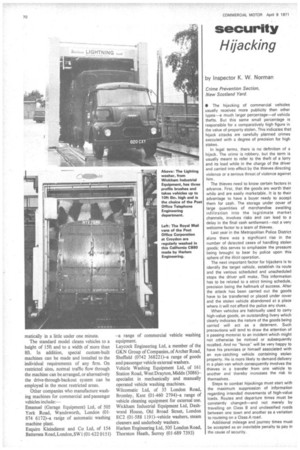Vehicle washing should be automatic
Page 70

Page 71

Page 72

If you've noticed an error in this article please click here to report it so we can fix it.
by Gordon Crabtree
IN the early 'fifties it was the general opinion that for most commercial road vehicles a once or twice fortnightly wash was adequate. But since these times goods and passenger operators alike have come to accept that a daily wash is good both for the company image, and vehicle livery and bodywork.
It is, however, apparently not so clear to a large number of operators that the cost of machine washing is low compared with that of manual labour—and also gives a bonus by removing corrosive elements which are the main cause of early deterioration in vehicles.
Contour brushes A vehicle's attractive appearance at the outset is of little use if it is washed only once a week, and then by hand, because this means that it will be dirty for most of its working life. However, increasing numbers of large and small operators are now realizing the absurdity of expensive vehicles presenting a below par appearance for 80 per cent of the time they are in use.
In recent years many businesses have decided that an auto-wash system is no longer a luxury. They can choose from a wide variety of machines and chemicals which can produce a smartly attired vehicle at low cost. Progress in design of washing machines has been handicapped to some extent by the wide range of shapes and sizes in the commercial vehicle field, but bus washing machine manufacturers are now overcoming the problems by the use of contour brushes.
One firm which is expert in this, Dawson and Barfos (Mfg) Ltd, of Cleckheaton, Yorkshire, has already tried a prototype Leyland National bus through its bus drive-through vehicle washer, the Universal Fivestar. This unit successfully incorporates two continuously revolving contourhugging side brushes with two streams of water from jet pipes. Singleand doubledeck buses are being washed daily on this machine by a large number of psv undertakings, SELNEC PTA being the latest to install one at a cost of £10,000 and achieving washing costs of between 2p and 4p per vehicle.
It is more economical for operators to have vehicles washed daily by a mechanical means than to give them a weekly hand wash. Corrosion is kept to a minimum and in the long run money is saved on labour costs. Take, for instance, a 50-vehicle fleet on a once-a-week hand washing system of outer cleaning. The method used is usually hose, detergent and long-handle brush. With a 50p per hour labour rate and assuming the average vehicle wash time is about two hours, the cost would be £50 a week with a time of 100 hours necessary to keep the fleet clean.
The economics By comparison it is interesting to look at the economics of a mechanical wash. The Britannia Emaculator mechanical washing machine manufactured by Smith Bros and Webb Ltd, of 269 Stratford Road, Birmingham 11, is typical. This equipment can wash a 50-vehicle fleet in hours daily, and the only labour required is the driver to drive through the appliance.
A detailed breakdown of costs shows:— ESTIMATED OPERATING COSTS Water 171p per 1000 gallons. Discharge through rinse pipes, 50 gpm, cost per 40sec rinse: 0.58p Electricity (domestic tariff) 1.5p. Power required, 1 hp=-0.745kw. Approx cost for 45sec operation
including starting joad: 0.07p Detergent (bulk price 25p per
gallon). Average ratio detergent/water 1/640. Detergent solution spraying
rate 17 gpm. Cost of detergent per
wash (30sec): 0.33p Replacement brushes (average life=
100,000 washes) at £200 per set: 0.20p TOTAL material costs per wash: 1.18p Depreciation over 10 years or 10 per cent of purchase price, at £2,420: £242 p.a.
Daily depreciation: £242.00 260 working days: 93p Daily material costs (50 x 1.2p): 60p Total daily operating costs (approximately 3p per vehicle wash): £1.53 Estimated savings Weekly labour costs of present
system (50 washes) £50.00 Weekly operating costs of Britannia system (250 washes) £7.65 Net savings per week claimed for mechanical auto-method £42.35
Commercial vehicle mechanical cleaning methods available today are largely based on two types—spray-only machines, and spray and brush machines. The former washer has a movable spray which is passed over the vehicle while delivering a detergent solution; the vehicle is then hand-brushed and the spray delivers a final rinse. This does not, of course, eliminate the cost of labour required for the hand-brushing but is nonetheless speedier and more economic than doing the job with a bucket and hose.
In the Ultrasonic system produced by Ultrasonic Machines Ltd, of 352 Bath Road, Slough, Bucks, a rectangular frame equipped with nozzles delivers a diluted acid water solution on to the vehicle for a minute or two. Later, a second spray of neutralizing alkaline solution is delivered in the same way, followed by a spray of clean water to give a final rinse. The sprays cover the full length of the vehicle as the frame is moved. Only heavy dirt deposits require brushing to remove. Users of this system estimate that costs are below 15p per vehicle wash.
Spray and brush Spray and brush machines available on the market from a number of firms deliver a water-detergent mix via wet spray pipes. Mechanical brushing followed by a rinse-off in clean water completes this operation. This method is used in two ways, either with the vehicle driven through the machine, or with a stationary vehicle which the machine traverses on a track, entirely automatically.
Smith Bros and Webb Ltd make machines for virtually every transport application. Their two-brush automatic drive-through washer, the Britannia, with patented hydraulic swing arms washes vehicles of all lengths and widths. The Britannia up-andover-machine has a separate front roof and back washing unit and can be installed where mechanical washing of these parts is desirable. This is controlled by an operator at a panel and is suited to awkwardly shaped vehicles with roof obstructions, as the brush can be lifted at will. This unit can be added to other makes of side washing machines.
Recently, an example of this new Britannia Emaculator automatic washing system has been installed in the vehicle maintenance section of the Lowfield (Storage and Distribu tion), St Helens depot. This procedure with the Emaculator gives a complete wash in an average of two minutes and involves only one operator. The system eliminates any need for hand washing, a task which used to take drivers 30 to 40 minutes each working day. Designed to cope with vehicles to a height of 15ft the first section of the machine comprises an overhead rotating brush together with a detergent drencher. It is push-button controlled and allows the operator to raise or lower the brush following the contours of the vehicle from front to rear as it is driven through.
The other section consists of two vertical pillars, housing detergent drenchers and the previously described controlled swing-arm with section brushes. A continuous, even pressure is applied to all side surfaces of the vehicle during its drive through.
Lowfield considered that• daily washing is important both in promoting the company's image and in removing corrosive salt deposits.
For mixed fleets The Dawson and Barfos drive-through washer is a boon to the operator with a mixed fleet. Where Dawson and Barfos LT models are installed with powered roof brush units they will handle vehicles up to I6ft 6in. high automatically. An alternative means of roof cleaning for this light transport cleaner is a "blanket" of needle felt which is trailed over the vehicle roof as it passes through. The blanket is continuously sprayed with water by a jet pipe.
The Dawson and Barfos LT washer is particularly economical if fitted with the special-flow apparatus as an optional extra on the rinse system. This gives a controlled flow through the rinse of 12.5 gal of water per 25 sec passage to prevent wastage of water. New-type automatic detergent metering can be fitted for the wash stage, as an option. It is mounted in a tank frame at the base of the side brush, with full control of detergent flow and shut-off valve to prevent entry of wash water to the detergent tank; this arrangement starts automatically with the wash pump.
The Dawson and I3arfos drive-through Fivestar unit available for bus and coach washing is fully automatic. The only person involved is the driver of the vehicle; the only hand finishing that is required is for the recesses in rear wheels. There are five brushes, four for the sides, and one for the roof.
In operation, a vehicle entering the washer depresses a pneumatic hose with the front offside wheel, and this signal activates the unit. As it moves into the machine it contacts the roof brush, which starts to clean the top. The bus passes to the first pair of brushes which clean the sides and rear. By this time the roof brush has finished the front and the second pair of brushes travel round the contours of the vehicle giving a double cleanse to these surfaces. Where both doubleand single-deck buses are being cleaned, an automatic sensing device is provided which sets the roof brush at the correct height before the vehicle enters the unit.
Underfloor sump The pump of the Fivestar draws detergent solution from an underfloor sump which forms part of the foundations. In this process a final cold rinse is given by jets mounted at the exit point. This rinse with cold mains water removes any residual soiling or detergent that may still be clinging to the vehicle.
Oliver Douglas and Co Ltd, Grangefield Industrial Estate, Leeds, makes proud claims for its pressure-jet washing machine. This will wash, brush and rinse a vehicle auto matically in a little under one minute.
The standard model cleans vehicles to a height of 15ft and to a width of more than 8ft. In addition, special custom-built machines can be made and installed to the individual requirements of any firm. On restricted sites, normal traffic flow through the machine can be arranged, or alternatively the drive-through-backout system can be employed in the most restricted areas.
Other companies who manufacture washing machines for commercial and passenger vehicles include:—
Emanuel (Garage Equipment) Ltd, of 505 York Road, Wandsworth, London (01874 6172)–a range of automatic washing machine plant.
Esquire Kleindienst and Co Ltd, of 154 Battersea Road, London, SW1 (01-622 0151) –a range of commercial vehicle washing equipment.
Laycock Engineering Ltd, a member of the GKN Group of Companies, of Archer Road, Sheffield (0742 368221)–a range of goods and passenger vehicle external washers. Vehicle Washing Equipment Ltd, of 161 Station Road, West Drayton, Middx (3086)– specialist in mechanically and manually operated vehicle washing machines.
Wilcomatic Ltd, of 35 London Road, Bromley, Kent (01-460 2794)–a range of vehicle cleaning equipment for external use. Wickham Industrial Equipment Ltd, Dashwood House, Old Broad Street, London EC2 (01-588 1191)–vehicle washers, steam cleaners and underbody washers.
Harlem Engineering Ltd, 505 London Road, Thornton Heath, Surrey (01-689 7393)




































































































































